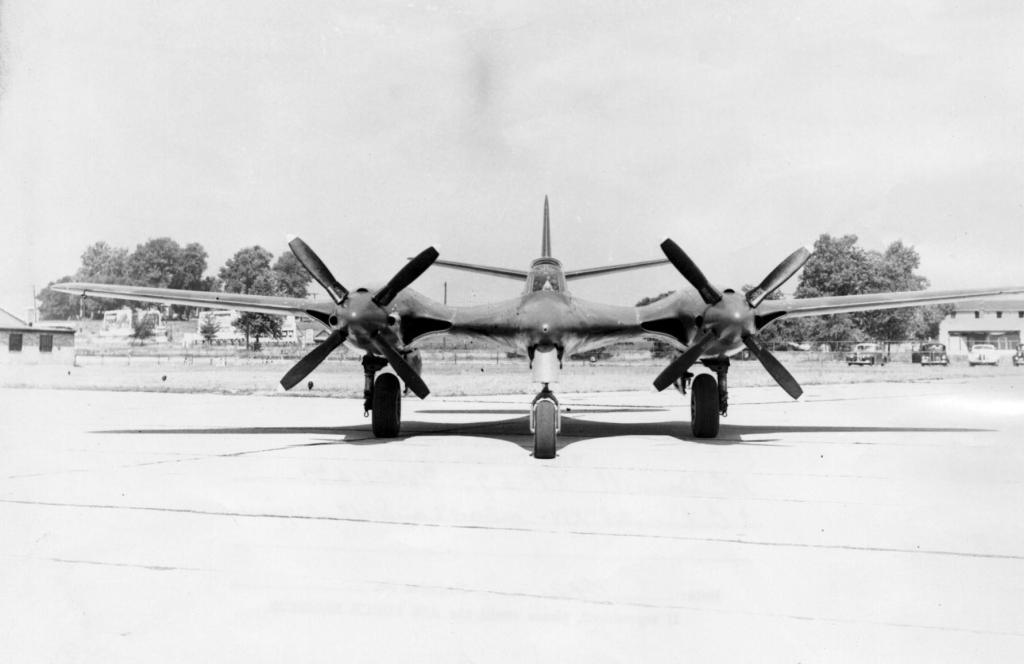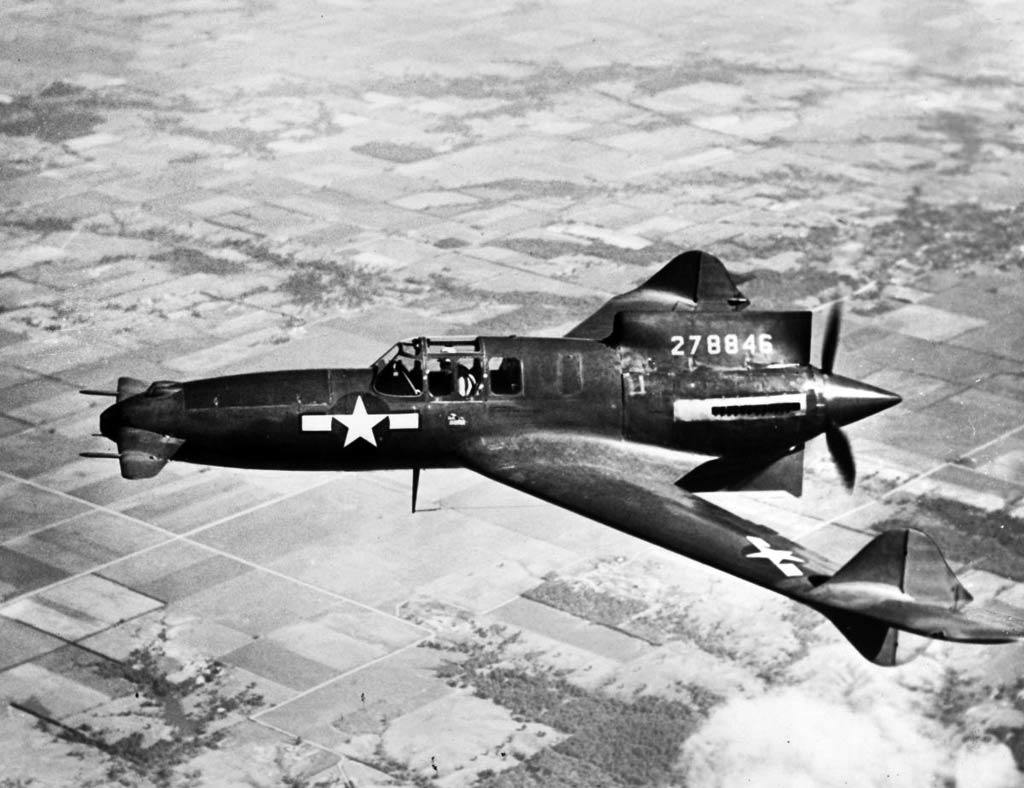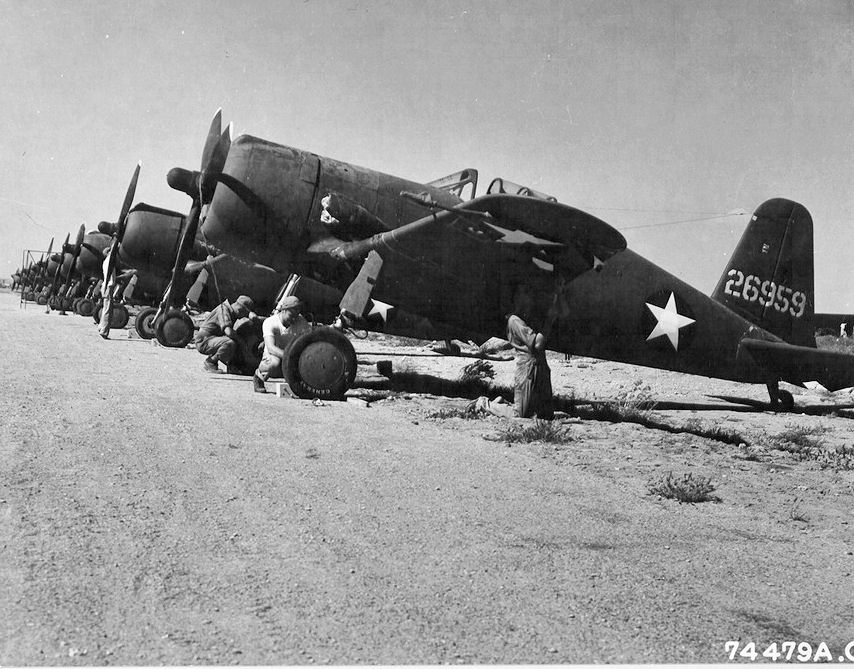10 Fabulous American Fighter Aircraft Killed by Fate

Rusting away in the desert of history, here are ten charismatic American fighter aircraft that failed to make the grade.
10. Grumman (G-34) XF5F-1 Skyrocket (1940) ‘The Un-reluctant Rocket’

Thirty years before the F-14 Tomcat, Grumman built another extremely advanced twin-engine carrier fighter, the superb G-34. Twin-engined carrier fighters were not a thing in 1940, but despite this the first example of this breed proved a winner. Trials in 1941 pitted the type against all the most advanced Allied fighters, including the XF4U Corsair, according to the man in charge of the test, “.. I remember testing the XF5F against the XF4U on climb to the 10,000 foot level. I pulled away from the Corsair so fast I thought he was having engine trouble. The F5F was a carrier pilot’s dream, as opposite rotating propellers eliminated all torque and you had no large engine up front to look around to see the LSO (landing signal officer) … The analysis of all the data definitely favored the F5F, and the Spitfire came in a distant second. … ADM Towers told me that securing spare parts … and other particulars which compounded the difficulty of building the twin-engine fighter, had ruled out the Skyrocket and that the Bureau had settled on the Wildcat for mass production.” The effort was not a waste of time however, as the design evolved into the Tigercat, one of the finest piston-engined fighters ever flown.
9. McDonnell XP-67 ‘Moonbat‘ (1944)

The radical aerodynamics of the Moonbat gave this US fighter prototype the look of flying stingray. The design emphasised low drag and the harvesting of a high amount of fuselage lift through a blended wing/body design. The fuselage, like the wing, had an aerofoil cross-section. This idea had been seen earlier on the Westland Dreadnought based on the blended fuselage-wing ideas of Russian inventor N. Woyevodsky, a Russian emigre scientist who lived in England.

The first two manifestations of this design failed to arouse the USAAF, but promises of a 472mph top speed tantalised the authorities and funding was granted. McDonnell considered serious armament options including a 75-mm gun.
The resultant aircraft flew in 1944 and proved the unknown adage ‘if it looks like a stingray it will fly like one’. It was underpowered, with poor handling, a long take-off run, terrible fuel consumption and stall characteristics even a 1940s test pilot didn’t have the bottle to explore. A prototype crashed and the project was deemed too dangerous to continue.
The blended wing body concept however has not died. It was later used with great success, among other, the SR-71 Blackbird. It is also, in its purest form, being studied for a number of future airliners concepts.

8. Northrop F-18L ‘Scornet’

The F/A-18 Hornet is no slouch in a dogfight, and the land-based F-18L was even better. Freed from the extra weight of carrier compatibility it was almost 30% lighter than the F/A-18A. This gave it is a superior range, manoeuvrability and enhanced almost other aspects of its already sparkling performance. It also boasted a Sparrow missile capability, something the F-16s of the time lacked. In fact, medium range weapons were not really carried by any other lightweight fighters in the 1970s.
The F-18L was offered to Canada for the New Fighter Aircraft Project of the late 1970s. It was a better aircraft for the role than the F/A-18A but the naval version had the backing of the extremely aggressive and effective McDonnell Douglas sales department and the benefit of being an ‘off-the-shelf’ product.
As an aside, the Canadian Hornet deal was almost dropped in favour of eighty secondhand Iranian F-14s Tomcats!
This site needs a small donation from you to continue. If you’ve enjoyed an article please donate here. It only takes a moment. Recommended donation £15.
7. Curtiss-Wright XF-87 Blackhawk (1948) ‘Wrong said Fred’

At the end of World War II Curtiss-Wright was the largest aircraft manufacturer in the world. Three years later it was gone. The nail in the coffin was the Blackhawk. The name followed a company naming tradition begun in the early 1930s for including ‘hawk’; their most successful fighters were the Tomahawk, Kittyhawk and Warhawk. There was nothing particularly terrible about the XF-87, although four engines is unusual in a fighter*. The USAF ordered the fighter (modified from an attack optimised design) before succumbing to the charms of the F-89 Scorpion and opting out.
It is often said that the company had been so busy in the mass production and incremental improvement of wartime aircraft types that they had not been able to respond to the jet revolution as well as their more forward-looking rivals. This is not entirely fair as they were working on some exceptionally fair as they worked on some exceptionally radical concepts, especially the XP-55 Ascender.
Other aircraft have used the name ‘Blackhawk’: there is the Carr Special racing aircraft of the 1930s, the S-67 attack helicopter and today’s famous S-70 series. I think there is another interwar type.. which I’ve forgotten.
*The Swiss EFW N-20 Aiguillon had four engines, and also failed to enter production
6. Curtiss-Wright XP-55 Ascender (1943) ‘The Cursed Starship’

In late 1939 the US had a pretty mediocre air force generally equipped with obsolete or mediocre aircraft. With international war erupting around the world it seemed a wise idea to rectify this situation, so the United States Army Air Corps issued R-40C, a requirement for radical new fighter concepts.
The emphasis on the aircraft as a high-speed gun platform with good visibility and acknowledgement that unconventional thinking was to be encouraged led to many of the 50 entrants who replied to the requirement adopting the pusher lay-out. The XP-55 was one of three designs given the thumbs-up to be produced in prototype form for evaluation.
Despite an utterly exotic appearance — canard fore-planes, a tricycle landing gear, a swept wing (for balance not to counter transonic drag) and a pusher engine, its performance was less-than-stellar. Far lower risk contemporary designs offered superior performance. But a speculative improved laminar flow wing version seemed promising so the programme carried on.
But the Ascender vicious stall characteristics could not be tamed and the programme ended after the third prototype crashed at Wright Field during an air show. This was the second crash of only three aircraft built. The risks were too high and the type offered nothing that couldn’t be done better by conventional fighters.

5. North American YF-93 ‘The Leggy Sabre’

THIS SITE NEEDS A SMALL DONATION FROM YOU TO CONTINUE. IF YOU’VE ENJOYED AN ARTICLE PLEASE DONATE HERE. IT ONLY TAKES A MOMENT. RECOMMENDED DONATION £15.
The superb F-86 Sabre design formed the basis of several aircraft, and the YF-93 was one of them. The rather handsome North American YF-93 was intended as a penetration fighter able to fly into the Soviet Union and destroy interceptors in their own airspace, and as a secondary task escort USAF bombers. It started as modified F-86 but soon grew different enough to merit its own designation. Compared to the Sabre it had far more fuel, twice the range and was far bigger. With the SCR-720 search radar and six 20 mm (.79 in) cannon occupying the nose, the nose intake of the F-86 was replaced with flush-mounted NACA-designed side intakes. Though very elegant in appearance, they were ineffective and replaced with a more conventional intake.
The arrival of a bomber, the B-47, with a similar top speed revealed the XF-93 to be too pedestrian in performance and the order for 118 aircraft was cancelled. It should be noted that the RAF accepted the Hawker Hunter into service in 1954, an aircraft of very similar top speed but with an inferior range.


4. Heinrich Pursuit ‘The Pursuit of hate’ (1917)

In 2020, nineteen months is insufficient time to develop and integrate a major software update on a warplane, but in 1917 it was a long time in a military aviation. The USA was only fighting in World War for nineteen months but in that time several attempts were to develop a high performance indigenous fighter from scratch. The Pursuit was powered by the 100 hp Gnome Monosoupape 9 Type B-2 nine-cylinder rotary engine and was of unequal-span biplane configuration.

Whereas the British Bristol F2.B of 1916 was named ‘Fighter’, a word which describes the mission to this day, Heinrich chose ‘Pursuit’ (the term ‘pursuit fighter’ in official terminology until the XP-92 of 1948).
Quite unlike the modern world in which the US will do almost anything to avoid buying foreign aircraft (see the tanker fiasco for example) the opposite was true in 1917. As with most many fledgling warplane producing nations, there was an initial preference for proven foreign designs. This is rather a shame as the Pursuit was a decent enough aeroplane of very clean aerodynamic form. Though not procured as a fighter it was seen to have potential as a fighter trainer. Two Mk II aircraft were ordered and these were particularly fine, with a cleaned up design offering a 77 kg weight reduction and inclusion of the more reliable Le Rhone 80 hp rotary engine.
3. Grumman XF10F Jaguar ‘The oldest swinger in town’ (1952)

As with most excellent carrier aircraft (certainly the Phantom II and Buccaneer among them) the road to the F-14 Tomcat was paved with the smoking carcasses of abysmal earlier efforts. If the F-14 were to write its own autobiography it would speak of the Grumman XF10F Jaguar as its drunken dysfunctional father, but a father nevertheless. Rambling mixed metaphors aside, the Jaguar was Grumman’s first attempt at a variable geometry warplane, and the first in the world to fly.
‘Swing-wings’ were very appealing to the US Navy, as they promised the docile take-off and landing characteristics of a straight-wing with the higher wing sweep required for trans- and super-sonic flight. Such promise could not be ignored and the Navy ordered 112 Jaguars
We sell fantastic high quality aviation-themed gifts here


It followed on from progress made by, among others, the Westland-Hill Pterodactyl IV of 1931, the British Vickers Wild Goose (1950) but more directly by the Messerschmitt P.1101 concept (unflown) and the experimental Bell X-5.

Test pilot Corwin ‘Corky’ Meyer, the only pilot to fly the Jaguar, found it as entertaining to fly “because there was so much wrong with it.” Among its issues: a dangerously unreliable XJ-40 experimental engine; poor stability; a cockpit canopy that opened in flight of its own accord and could not be shut and left the pilot unable to eject; shoddy manufacturing that – in one case a 5-inch screw was used where .4 should have been, mangling the delicate electronic circuitry within; jamming of the wing mechanism as poorly maintained hydraulic fluid turned to jelly.So much attention had been paid to getting the wing sweep mechanism right, that other aspects had been neglected. The wing sweep mechanism was pretty much the only part of the Jaguar that did work flawlessly. Even by 1950s naval (and experimental) standards this was clearly a terrible aeroplane, and after 32 test flights the project was mercifully halted and the order cancelled.
2. Lockheed XF-90 ‘Screamin’ Jet Hawkins’

A competitor to the YF-93 above, the futuristic XF-90 was designed at the Skunk Works by Willis Moore Hawkins under the supervision of the US master of aircraft design and amateur arm wrestler, Kelly Johnson. Though lacking the fame of Johnson, Hawkins was a very important figure. He worked on many projects including the Constellation and F-104, and was instrumental in the creation of both the C-130 and Abrams main battle tank. The XF-90 was not his finest moment and its relatively lacklustre performance found it losing out to the XF-88. Still, an extremely good looking machine.
- Vultee P-66 Vanguard ‘Brute 66’

If you described a modern fighter as ‘cancelled’ despite 146 being produced you’d be labelled a wack-job and carted off to an anti-mask Flat Earther Trump rally to hang out with new friends. But this was in a time when fighter aircraft were produced in their thousands. Even the less than A-list Bell P-39 Airacobra production total was pushing 10,000 (so I think it is fair to include the Vanguard. I also want to include it as it seldom gets a mention in aviation history books.
So sleek was the cowling on early examples you be forgiven for mistaking the Vanguard for having an inline engine but it was actually a radial, a 1200 hp Pratt & Whitney R-1830-33 Twin Wasp. But this figure-hugging cowling caused the engine to overheat and was replaced with one of more conventional appearance.

The P-66 had generally excellent handling and a decent performance. In 1940 the Swedish government ordered 144 as the V-48C. The V-48C had a heavier armament (two fifty cals and four rifle-calibre machine-guns) and improved high altitude performance. Following the Pearl Harbor attack, the US decided there was better things to do with fighters than export them to a neutral country and an embargo was placed on aircraft for Sweden. Fifty were taken into the USAAF for both pursuit and pursuit training roles. Much of this order then given to the Royal Air Force of Britain who hated the type and decided to give them to China. The British planned to use them as a trainer force based in Canada but their tendency to ground-loop, their fragility and the political goodwill of gifting them to China all contributed to the RAF letting them go. These airframes went on a epic adventure travelling to India in USAAF colours where both testing and the perilous transit to China destroyed many of the aircraft.
Two Chinese squadrons took the P-66 into combat from 1943 but they took a mauling. When not being destroyed by friendly anti-aircraft forces unfamiliar with this rare shape they were shot down by faster and more agile Japanese types using superior tactics. In 1943 they were replaced by P-40s. A small number of surviving P-66s were hidden in caves in Chungking for use in the civil war against Mao’s communist, but as late as 1947 they were generally still in their crates.
NEW DEAL
Upgrade your pledge to The Hush-Kit Book of Warplanes and see what you can get



Tea Towel and Badge with Signed Book
A high quality tea towel decorated with the original ‘blood chit’ design handed to British aircrews flying missions over Soviet controlled regions in World War II. Disclaimer: We cannot guarantee the safety of aircrew who use these if downed over modern Russia.
PLUS:
- WW2 replica badge
- Signed first edition
- Your name printed in the book
- Ebook
If you haven’t yet pre-ordered your copy you can do it here


I’m surprised that neither the F-20, nor the YF-23, are on this list.
Hi Peter, I tried to avoid aircraft I’ve mentioned in previous articles. Both fantastic machines though. Cheers, HK
Curtiss was involved in several WWII aircraft projects, none of which amounted to a hill of beans. There is the P-60, which started out as an updated P-46, which was an updated P-40. It first flew in 1941, but with accelerated aeronautical development and changing requirements, by 1945 had morphed into a more ungainly and tubby P-47. Think about that for a minute. Then there was the P-62, a high altitude fighter for the Army, the F14C, a high altitude fighter for the Navy, and the XTBC a single seat Navy attack aircraft, This is something that could have been accomplished with variants on the same airframe, but Nooooooo- Three airframes, three engines, three design teams, etc. And, money going out the door three times as fast. As usual with Curtiss, changing requirements and day late and a dollar short products were the norm. Then there was the XTB2C which lost to the Skyraider when Douglas had the magic touch, and the mixed power F15C which was left behind by advances.
On a completely different tack, you comment made me wonder: which aircraft design went through the most evolutions?
Eg Bristol built the Type 142, which became the Blenheim mk.I, which was substantially altered to become the Blenheim mk.IV (and spun off as the Bolingbroke), and then used as the basis for the Beaufort, which became the Beaufighter. I’m sure there’s many other examples.
The P-47G was the Republic Thunderbolt , not a Curtiss design at all but a plane the government made Curtiss build under license at its Buffalo plant instead of the cancelled XP-60s
The name of the M-1 is Abrams, not “Abrahams”.
I respect the list but it is missing 1 that would actually dramatically change history, had the Lockheed L-133 been selected by the US Army Air Corps and WWII would have probably ended a couple of years sooner, at least in Europe
at the latest the L-133 would be ready by 1944 and would sweep any German aircraft clearing the path for the bombers to destroy EVERY aircraft, tank and munitions factory reducing Germany’s ability to continue waging war to ZERO